Turn-on Type Chemical Sensing of Vitamin K4 by Fluorene Dendrimers with Naphthalene Segments
Abstract
:1. Introduction
2. Results and Discussion
2.1.Synthesis of G1 and G2 Dendrimers
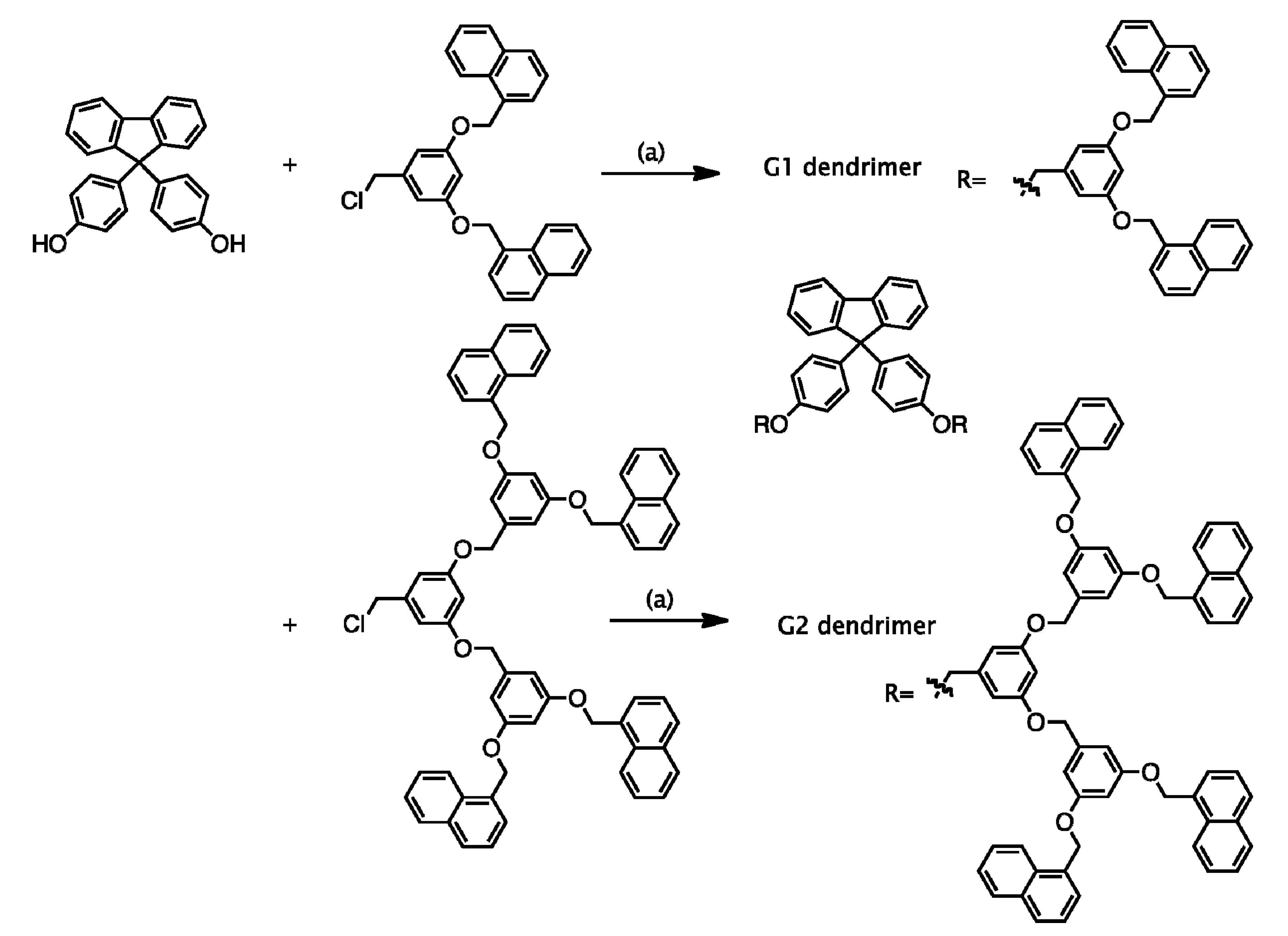
2.2. Optical Properties
| Abs λ (nm) | ε (M−1 cm−1) | Emission λ (nm) | |
|---|---|---|---|
| G1 dendrimer | 283 | 60,000 | 330 |
| G2 dendrimer | 283 | 110,000 | 330, 440 |
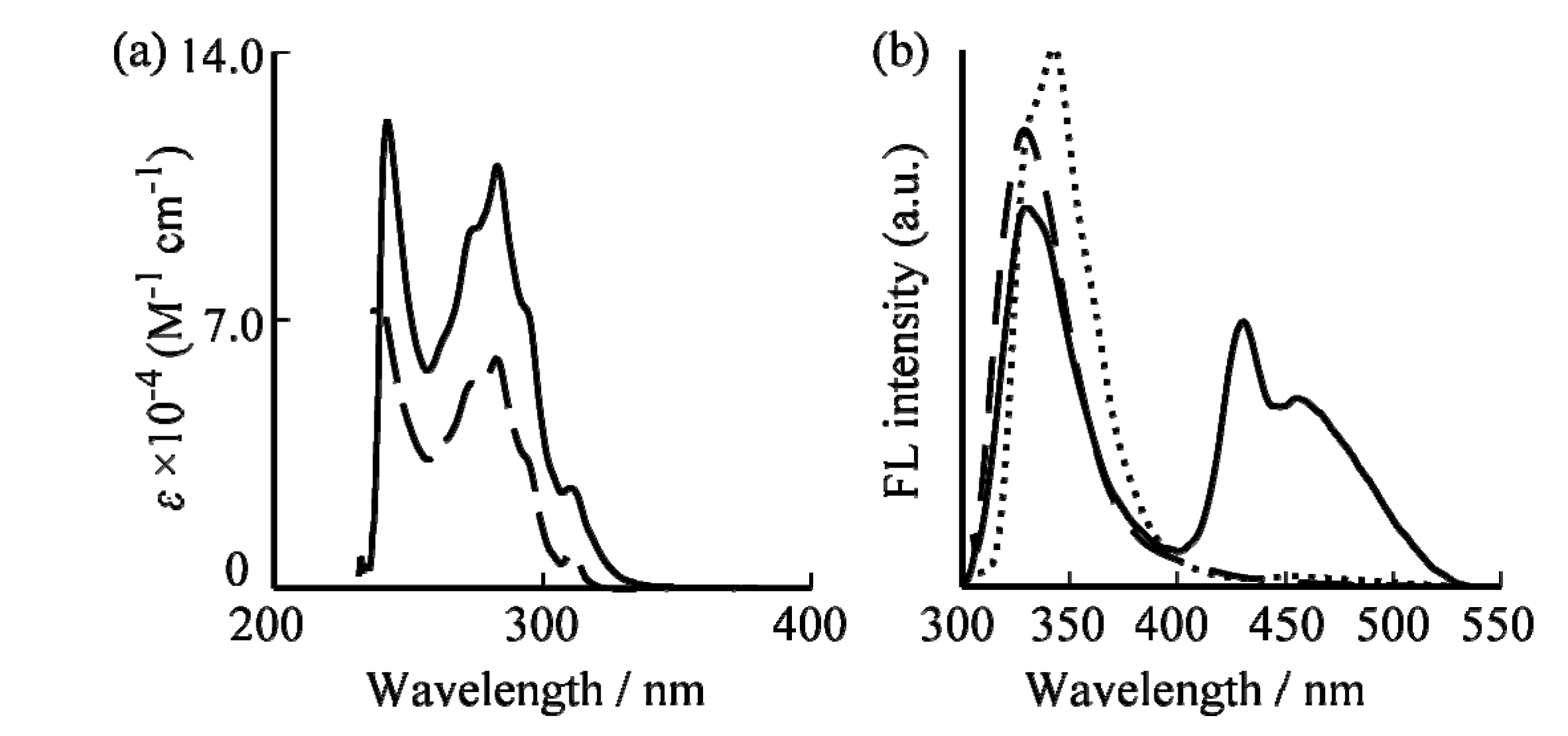
2.3. UV-Vis and Fluorescence Detection of Vitamin K4
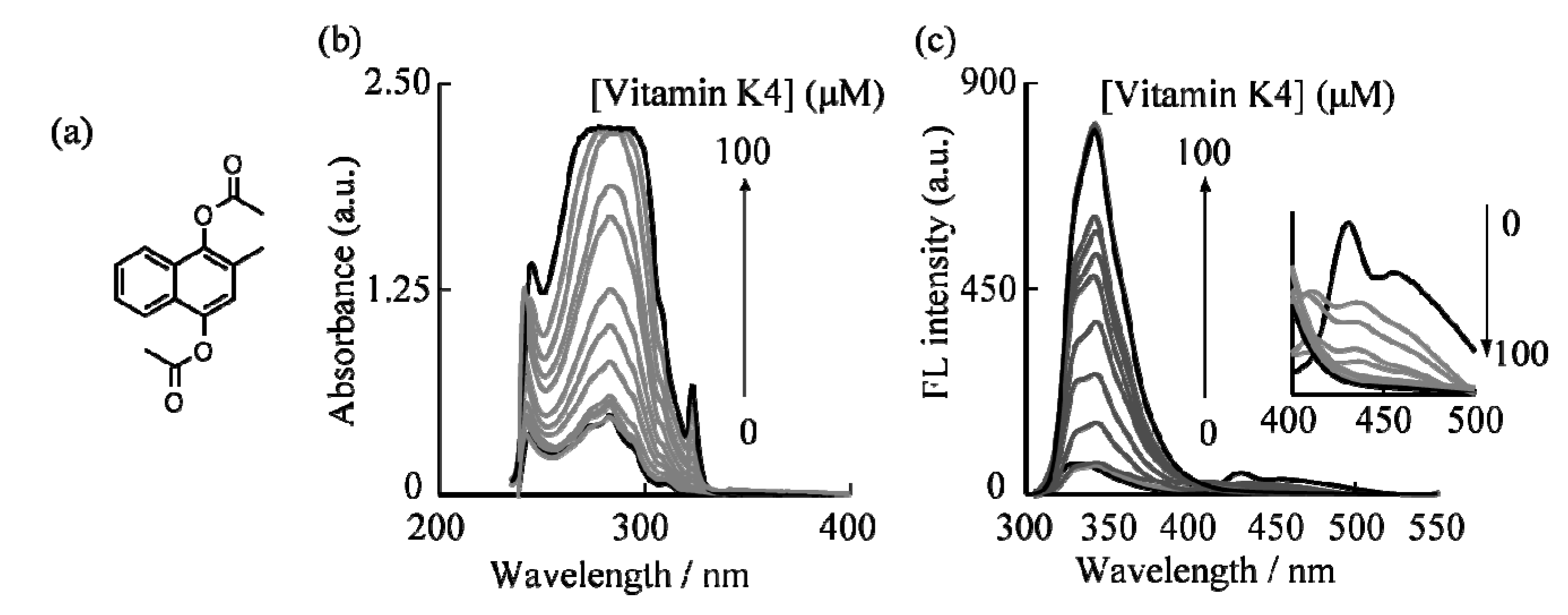
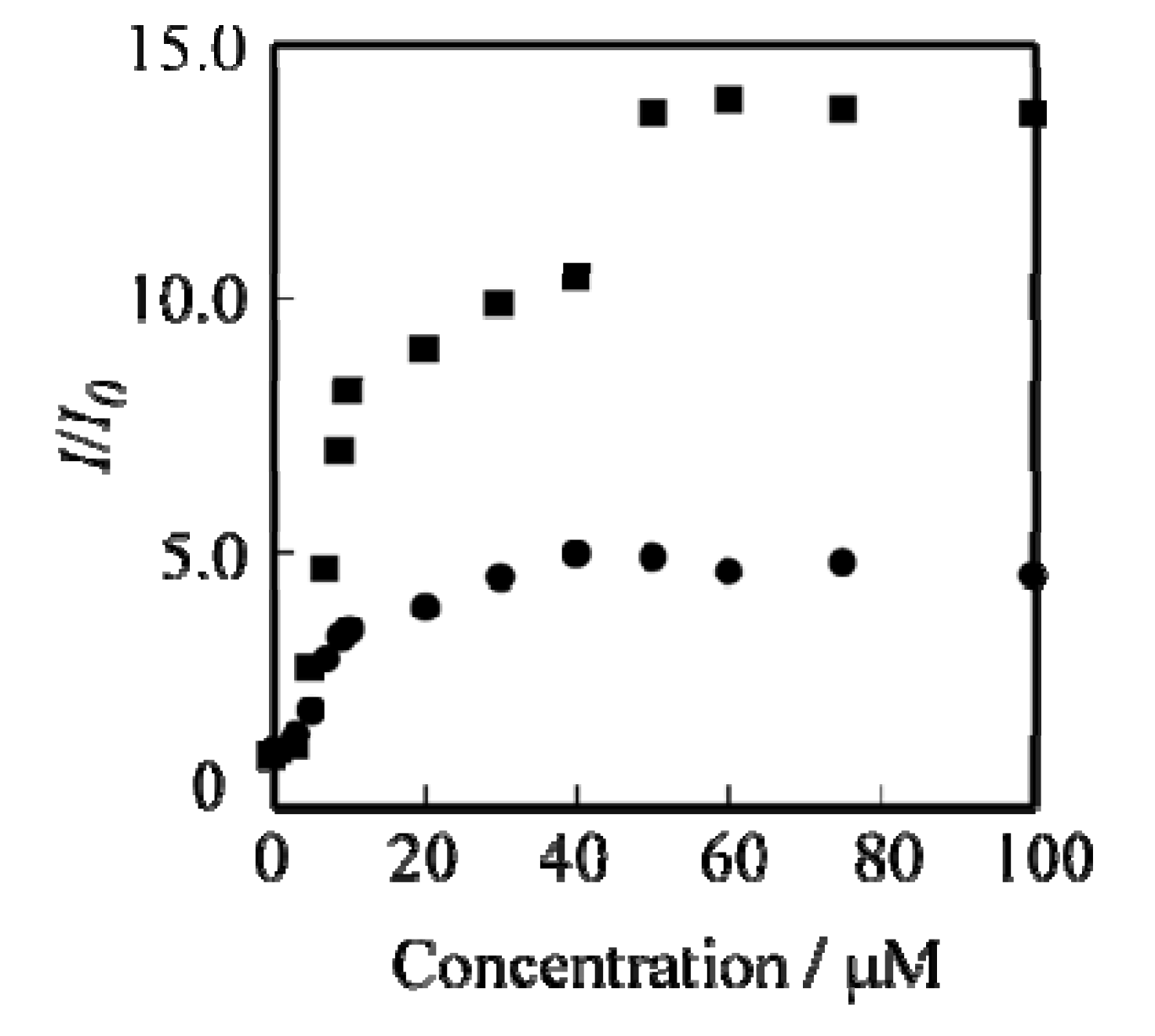
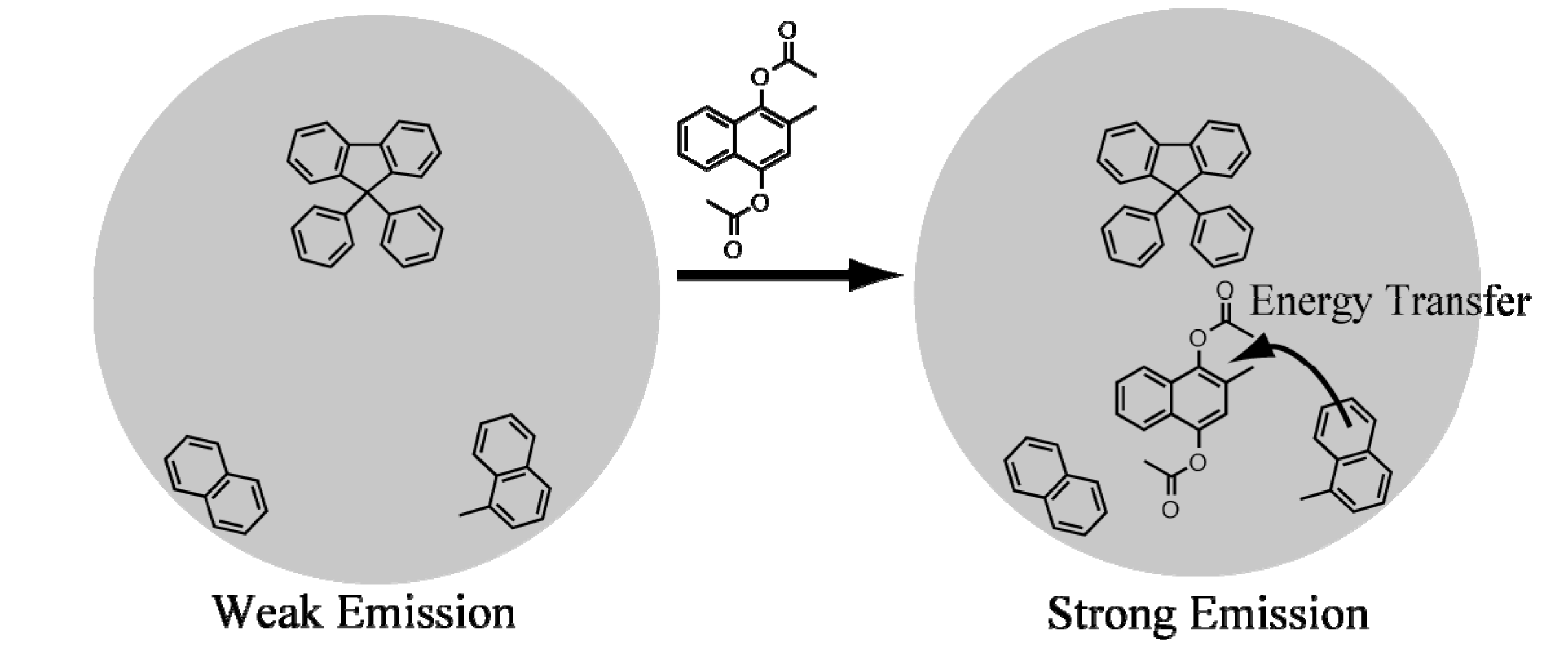
3. Experimental
3.1. General
3.2. Synthesis of G1 and G2 Dendrimers
4. Conclusions
Acknowledgments
Author Contributions
Conflicts of Interest
References
- Woods, S.C.; Seeley, R.J.; Porte, D., Jr.; Schwartz, M.W. Signal that regulate food intake and energy homeostasis. Science 1998, 280, 1378–1383. [Google Scholar] [CrossRef]
- Dusso, A.S.; Brown, J.; Slatopolsky, E. Vitamin D. Am. J. Physiol. Renal. Physiol. 2005, 289, F8–F28. [Google Scholar] [CrossRef]
- Bolton-Smith, C.; Price, R.J.; Fenton, S.T.; Harrington, D.J.; Shearer, M.J. Compilation of a provisional UK database for the phylloquinone (vitamin K1) content of foods. Br. J. Nutr. 2000, 83, 389–399. [Google Scholar]
- Booth, S.L. Vitamin K: Food composition and dietary intakes. Food Nutr. Res. 2012, 56, 5505–5569. [Google Scholar]
- Fairfield, K.M.; Fletcher, R.H. Vitamins for chronic disease prevention in adults. J. Am. Med. Assoc. 2002, 287, 3116–3126. [Google Scholar] [CrossRef]
- Feskanich, D.; Weber, P.; Willett, W.C.; Rochett, H.; Booth, S.L.; Colditz, G.A. Vitamin K intake and hip fractures in women: A prospective study. Am. J. Clin. Nutr. 1999, 69, 74–79. [Google Scholar]
- Kamao, M.; Suhara, Y.; Tsugawa, N.; Uwano, M.; Yamaguchi, N.; Uenishi, K.; Ishida, H.; Sasaki, S.; Okano, T. Vitamin K content of foods and dietary vitamin K intake in Japanese young women. J. Nutr. Sci. Vitaminol. 2007, 53, 464–470. [Google Scholar] [CrossRef]
- Yan, L.; Zhou, B.; Greenberg, D.; Wang, L.; Nigdikar, S.; Prynne, C.; Prentice, A. Vitamin K status of older individuals in northern China is superior to that of older individuals in the UK. Br.J.Nutr. 2004, 92, 939–945. [Google Scholar] [CrossRef]
- Hejna, M.; Raderer, M.; Zielinski, C.C. Inhibition of metastases by anticoagulants. J. Natl. Cancer Inst. 1999, 91, 22–36. [Google Scholar] [CrossRef]
- Yoshida, M.; Booth, S.L.; Meigs, J.B.; Saltzman, E.; Jacques, P.F. Phylloquinone intake, insulin sensitivity, and glycemic status in men and women. Am. J. Clin. Nutr. 2008, 88, 210–215. [Google Scholar]
- Rost, S.; Fregin, A.; Ivaskevicius, V.; Conzelmann, E.; Hörtnagel, K.; Pelz, H.-J.; Lappegard, K.; Seifried, E.; Scharrer, I.; Tuddenham, E.G.D.; et al. Mutation in VKORC1 cause warfarin resistance and multiple coagulation factor deficiency type 2. Nature 2004, 427, 537–541. [Google Scholar] [CrossRef]
- Tabb, M.M.; Sun, A.; Zhou, C.; Grün, F.; Errandi, J.; Romero, K.; Pham, H.; Inoue, S.; Mallick, S.; Lin, M.; et al. Vitamin K2 regulation of bone homeostasis is mediated by the steroid and xenobiotic receptor SXR. J. Biol. Chem. 2003, 278, 43919–43927. [Google Scholar] [CrossRef]
- Shea, M.K.; Booth, S.L.; Massaro, J.M.; Jacques, P.F.; D’Agostino, R.B., Sr.; Dawson-Hughes, B.; Ordobas, J.M.; O’Donnell, C.J.; Kathiresan, S.; Keaney, J.F., Jr.; et al. Vitamin K and vitamin D status: Associations with inflammatory markers in the framingham offspring study. Am. J. Epidemiol. 2008, 167, 313–320. [Google Scholar]
- Nollet, L.M.L.; Toldrá, F. Food Analysis for HPLC, 3rd ed.; CRC Press: New York, NY, USA, 2013. [Google Scholar]
- Kowalski, J.; Płoszyńska, J.; Sobkowiak, A. Electrochemical oxidation of 2-methylnaphthalene-1,4-diacetate. J. Appl. Electrochem. 1998, 28, 1261–1264. [Google Scholar] [CrossRef]
- Zhang, L.; Li, T.; Ohsaka, T.; Mao, L. Charge-transfer interaction between melamine and quinones: Towards voltammetric determination of malamine. Electrochem. Commun. 2013, 26, 89–92. [Google Scholar] [CrossRef]
- Percec, V.; Ahn, C.-H.; Cho, W.-D.; Jamieon, A.M.; Kim, J.; Leman, T.; Schmidt, M.; Gerle, M.; Möller, M.; Prokhorova, S.A.; et al. Visualizable cylindrical macromolecules with controlled stiffness from backbones containing libraries of self-assembling dendritic side groups. J. Am. Chem. Soc. 1998, 120, 8619–8631. [Google Scholar] [CrossRef]
- Yamamoto, K.; Higuchi, M.; Shiki, S.; Tsuruta, M.; Chiba, H. Stepwise radial complexation of imine groups in phenylazomethine dendrimers. Nature 2002, 415, 509–511. [Google Scholar] [CrossRef]
- Astruc, D.; Boisselier, E.; Ornelas, C. Dendrimers designed for function: From physical, photophysical, and supramolecular properties to applications in sensing, catalysis, molecular electronics, photonics, and nanomedicine. Chem. Rev. 2010, 110, 1857–1959. [Google Scholar] [CrossRef]
- Lo, S.-C.; Burn, P.L. Development of dendrimers: Macromolecules for use in organic light-emitting diodes and solar cells. Chem. Rev. 2007, 107, 1097–1116. [Google Scholar]
- Li, W.-S.; Aida, T. Dendrimer porphyrins and phthalocyanines. Chem. Rev. 2009, 109, 6047–6076. [Google Scholar] [CrossRef]
- Schenning, A.P.H.J.; Peeters, E.; Meijer, E.W. Energy transfer in supramolecular assemblies of oligo(p-phenylene vinylene)s terminated poly(propylene imine) dendrimers. J. Am. Chem. Soc. 2000, 122, 4489–4495. [Google Scholar] [CrossRef]
- Gingras, M.; Placide, V.; Raimundo, J.-M.; Bergamini, G.; Ceroni, P.; Balzani, V. Polysulfurated pyrene-cored dendrimers: Luminescent and electrochromic properties. Chem. Eur. J. 2008, 14, 10357–10363. [Google Scholar] [CrossRef]
- Tang, G.; Chen, S.S.Y.; Shaw, P.E.; Hegedus, K.; Wang, X.; Burn, P.L.; Meredith, P. Fluorescent carbazole dendrimers for the detection of explosives. Polym. Chem. 2011, 2, 2360–2368. [Google Scholar] [CrossRef]
- Srikun, D.; Albers, A.E.; Chang, C.J. A dendrimer-based platform for simultaneous dual fluorescence imaging of hydrogen proxide and pH gradients produced in living cells. Chem. Sci. 2011, 2, 1156–1165. [Google Scholar] [CrossRef]
- Yamaji, D.; Takaguchi, Y. A novel fluorescent fluoride chemosensor based on unmodified poly(amidoamine) dendrimer. Polym. J. 2009, 41, 293–296. [Google Scholar] [CrossRef]
- Kawakami, J.; Isobe, T.; Sasaki, Y.; Ito, S.; Nagaki, M.; Kitahara, H. Poly(amide amine) dendrimer with naphthyl units as a fluorescent chemosensor for metal ions. Anal. Sci. 2005, 21, 729–730. [Google Scholar] [CrossRef]
- Kawakami, J.; Mizuguchi, T.; Ito, S. Poly(amine ester) dendrimer with naphthyl units as a fluorescent chemosensor for Al(III), Cu(II), and Zn(II). Anal. Sci. 2006, 21, 1383–1384. [Google Scholar] [CrossRef]
- Grayson, S.M.; Fréchet, J.M.J. Convergent dendrons and dendrimers: From synthesis to applications. Chem. Rev. 2001, 101, 3819–3867. [Google Scholar] [CrossRef]
- Hawker, C.J.; Fréchet, J.M.J. Preparation of polymers with controlled molecular architecture. A new convergent approach to dendritic macromolecules. J. Am. Chem. Soc. 1990, 112, 7638–7647. [Google Scholar] [CrossRef]
- Saudan, C.; Balzani, V.; Ceroni, P.; Gorka, M.; Maestri, M.; Vicinelli, V.; Vögtle, F. Dendrimers with a cyclam core. Absorption spectra, multiple luminescence, and effect of protonation. Tetrahedron 2003, 59, 3845–3852. [Google Scholar] [CrossRef]
- Saudan, C.; Balzani, V.; Ceroni, P.; Gorka, M.; Lee, S.-K.; Maestri, M.; Vicinelli, V.; Vögtle, F. Dendrimers as ligands. Formation of a 2:1 luminescent complex between a dendrimer with a 1,4,8,11-tetraazacyclotetradecane (cyclam) core and Zn2+. J. Am. Chem. Soc. 2003, 125, 4424–4425. [Google Scholar]
- Zeng, Y.; Li, Y.; Li, M.; Yang, G.; Li, Y. Enhancement of energy utilization in light-harvesting dendrimers by the pseudorotaxane formation at periphery. J. Am. Chem. Soc. 2009, 131, 9100–9106. [Google Scholar] [CrossRef]
- Bao, B.; Tao, N.; Ma, M.; Zhang, L.; Yuwen, L.; Fan, Q.; Wang, L.; Huang, W. Fluorescence turn-on sensing of ascorbic acid based on a hyperbranched conjugated polyelectrolyte. Soft Mater. 2014, 12, 73–78. [Google Scholar] [CrossRef]
- Sample Availability: Samples of the all compounds are available from the authors.
© 2014 by the authors. Licensee MDPI, Basel, Switzerland. This article is an open access article distributed under the terms and conditions of the Creative Commons Attribution license ( http://creativecommons.org/licenses/by/3.0/).
Share and Cite
Adachi, N.; Sugiyama, H.; Arai, M.; Ogawa, H. Turn-on Type Chemical Sensing of Vitamin K4 by Fluorene Dendrimers with Naphthalene Segments. Molecules 2014, 19, 4135-4144. https://doi.org/10.3390/molecules19044135
Adachi N, Sugiyama H, Arai M, Ogawa H. Turn-on Type Chemical Sensing of Vitamin K4 by Fluorene Dendrimers with Naphthalene Segments. Molecules. 2014; 19(4):4135-4144. https://doi.org/10.3390/molecules19044135
Chicago/Turabian StyleAdachi, Naoya, Hiroki Sugiyama, Masafumi Arai, and Hideo Ogawa. 2014. "Turn-on Type Chemical Sensing of Vitamin K4 by Fluorene Dendrimers with Naphthalene Segments" Molecules 19, no. 4: 4135-4144. https://doi.org/10.3390/molecules19044135
APA StyleAdachi, N., Sugiyama, H., Arai, M., & Ogawa, H. (2014). Turn-on Type Chemical Sensing of Vitamin K4 by Fluorene Dendrimers with Naphthalene Segments. Molecules, 19(4), 4135-4144. https://doi.org/10.3390/molecules19044135





